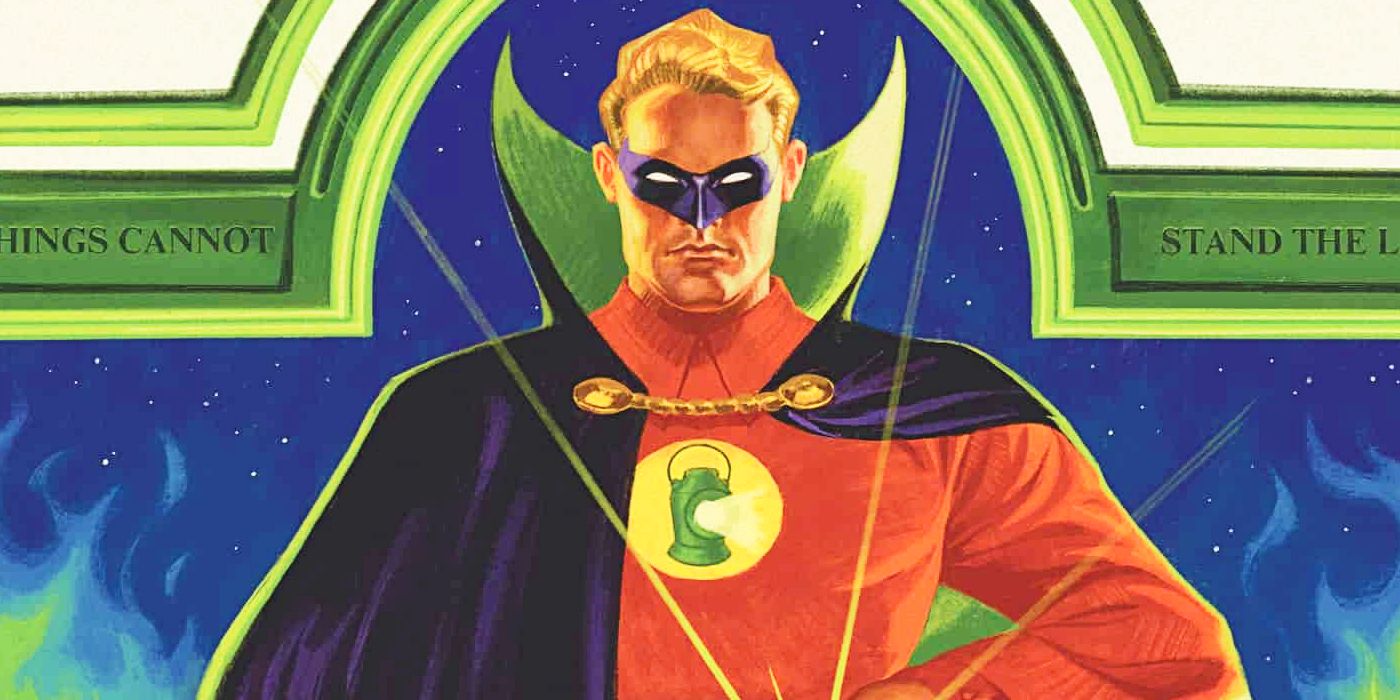[[{“value”:”
Summary
Alan Scott: The Green Lantern
modernized a classic character, expanded DC lore, and cemented Scott as a queer icon.
The series introduced the Emerald Flame, expanded Red Lantern mythos, and set the stage for future Lantern stories.
The love-hate dynamic between Alan Scott and Vlad Sokov added depth, with Vlad emerging as a complex and compelling villain.
After a fantastic six-issue run, Alan Scott: The Green Lantern served as a major leap forward for the title character in more ways than one. This book is the latest entry in DC’s New Golden Age, initiated in hopes of refashioning old school heroes to fit within the new school canon of DC, and Alan Scott is by far the cream of the crop.
In the time since the release of the series’ conclusion, Alan Scott: The Green Lantern #6 by Tim Sheridan and Cian Tormey, it becomes especially evident that the series has achieved exactly what it set out to do and more, easily becoming one of the most underrated DC series of the year.
This series managed to achieve the task of modernizing a classic character, expanding DC’s lore with interesting supporting characters, offering enough new lore to revisit in the future, and cementing the original Green Lantern as a queer icon. That’s a lot to ask for, but it speaks to how impressive the series is as an instant classic by pulling it all off.
JSA’s New Roster Revealed as New Series Unleashes the ORIGINAL Justice League
DC announced a new JSA series at San Diego Comic-Con, and it will not only feature classic team members, but their children as well.
DC Completely Succeeds in Modernizing Alan Scott
Updating an 84-Year-Old Character for 2024
It can be argued that no character in DC’s New Golden Age project was in more need of a modern update than Alan Scott, specifically because he was recontextualized a few years ago as a gay man. It’s new information that adds so much to the character, but readers needed to see how this new aspect of Alan’s identity could weave into his adventures of yesteryear, especially as far as what it looked like for a closeted male superhero to live in the 20th century during the height of World War II.
This historical context is where Alan Scott: The Green Lantern comes into play, making the original Green Lantern more relatable as a character than he’s ever been. Scott’s righteous, noble moral code always made him practically the perfect hero, which may not be easy for every reader to relate to. After all, nobody’s perfect. To compensate, the series focuses on Alan’s imperfections, namely his guilt and shame regarding who he is, as well as his misdirected anger toward accepting who he is.
Every reader can relate to someone who is constantly doubting themselves and who they are, is insecure about their identity, and is wondering if they’ve chosen the right path in life.
Not every reader can relate to the perfect boy scout of a superhero, with the chiseled jawline, 1940s ethics, and matchstick charisma. However, every reader can relate to someone who is constantly doubting themselves and who they are, is insecure about their identity, and is wondering if they’ve chosen the right path in life. Even for readers who aren’t gay, these are universal feelings, and they help flesh out Alan Scott to fit the modern world, all while updating his origin story.
DC Expands Green Lantern Lore with Fascinating, Magical Changes
The World of the Green and Red Lantern
As much as this series has helped elevate the history and background of Alan Scott, it’s done just as much (if not more) for the overall Green Lantern mythology. Perhaps the most significant addition to Green Lantern lore isthe introduction of the Emerald Flame, which works similarly to the Flash’s Speed Force. The Emerald Flame is a cosmic space that exists in-between realities, where the Flame manifests itself in corporeal form to someone the Lantern trusts. While Scott is the first true user of the Emerald Flam, there’s the potential for other Lanterns to visit and speak to the Emerald Flame in the future.
Alan Scott fans need to keep their eye out for his next co-starring appearance in the newly-announced
Justice Society of America
title from Jeff Lemire and Diego Olortegui, arriving Fall 2024 as part of DC’s “All In” initiative.
This series also went a long way to expanding Lantern lore, not just in terms of Green Lantern mythos, but also Red Lantern mythos. The mysterious Red Flame pre-dates the Red Lantern Corps, and at this point in history, people witness for the first time just how dangerous the Crimson Flame can be. The stakes of the Crimson Flame are made even more personal when it quite literally rips Alan Scott’s lover, Johnny Ladd, from his arms. When that lover resurfaces, he shows his true colors (literally) as not Johnny but Vladimir Sokov, a Russian spy dubbing himself the Red Lantern.
The Lovers-to-Enemies Romance Adds a New Layer to the Story
Vladimir Sokov’s Red Lantern first makes a brief appearance in The New Golden Age #1 by Geoff Johns and various artists, and he is then mentioned in 2023’s Justice Society of America #8 by Johns, Mikel Janín, Jordie Bellaire, and Rob Leigh as a “very sensitive subject” for the Green Lantern. Because it’s such a sensitive topic, he fails to mention just how personal his connection with Vlad is as a former lover turned rival. One of the sheer highlights of this series is the soap opera-like melodrama, and the love-hate dynamic between the Red and Green Lantern helps drive that melodrama.
For those who aren’t fans of melodrama, they can certainly enjoy what the series has to offer in terms of exciting action sequences.
For those who aren’t fans of melodrama, they can certainly enjoy what the series has to offer in terms of exciting action sequences. One of the best fights of this series (and the best fight of this year) is the fight between the Red and Green Lanterns, which is just as story-driven as it is an adrenaline rush. Their complicated, compelling dynamic is on full display during this fight. Alan is shellshocked and confused at the prospect that his presumed dead lover is not only alive and a turncoat, but claims to have never loved him.
That confusion builds into a rage once Alan charges his ring with Vlad’s Red Lantern, which builds into genuine concern from Vlad. The harder that Vlad tries not to admit that his feelings for Alan were genuine while he was undercover, the easier it becomes for those feelings to sneak their way up to the surface. Even more compelling is one of Vlad’s final lines during the series after he’s confronted about why he killed The Crimson Host: “I’m the villain.”
It’s genuinely heartbreaking to see a man who has potential for good in him but is too committed to living the narrative created for him. He was experimented on to play the part of a monster, and so he acted accordingly. There are so many fascinating layers to Vladimir Sokov as a character that, hopefully, this series will not be the last time that readers see him. Especially following the twist ending, there is too much that is still left to explore with the Red Lantern to leave it dormant on the table.
“Bonded. Eternally. Inextricably.”: Green Lantern’s Tragic Romance Gives Alan Scott DC’s Best Love Story in Years
The latest twist in Alan Scott’s unfolding love story doesn’t just rewrite Green Lantern lore — it sets the bar for superhero romances from every era.
Alan Scott: The Green Lantern Establishes Itself as an Essential Queer Comic
This is not just a story about how Alan Scott discovers his power as the Green Lantern, but how the Green Lantern discovers the power he holds as a queer man.
One of the best aspects of Alan Scott’s coming out is that this series doubles as not only a Green Lantern story, but a queer text. This allows the creative team to bridge the gap between superhero storytelling and queer storytelling, namely by connecting Green Lantern’s willpower to the willpower of the 20th-century queer experience. This is not just a story about how Alan Scott discovers his power as the Green Lantern, but how the Green Lantern discovers the power he holds as a queer man.
Alan Scott: The Green Lantern is a masterclass of storytelling that interweaves queerness into DC’s history. The way the series expands on the Green Lantern’s mythology will forever cement its place in the DC canon, but the way it handles complicated, relatable discussions regarding queer experiences in the 20th century is what will cement it forever in the minds of readers for years to come. Alan Scott: The Green Lanternis a must-read and an instant classic, and it is, by far, one of the best series that DC Comics has to offer in 2024.
Alan Scott: The Green Lantern #6 is available now from DC Comics. The collected edition is available September 24th, 2024.
ALAN SCOTT: THE GREEN LANTERN #6 (2024)
Writer: Tim Sheridan Artist: Cian Tormey Inker: Jordi Tarragona Colorist: Matt Herms Letterer: Lucas Gattoni Cover Artist: David Talaski
Alan Scott: The Green Lantern
The Green Lantern is the most powerful member of the JSA, beloved by all of America, but his personal life is a well-kept secret. Both his public and private life are threatened when he’s framed by a mysterious killer, and the victims are people from his past! This is a story about love, about fear, and most of all about courage to stand up to that fear. Alan Scott’s past is the key to his future when the Red Lantern appears, ready to strike down the mighty Green Lantern! Can Alan Scott stop his enemy’s monstrous plans?
“}]] Alan Scott finally got the story he deserves. Read More

